With hindsight, I might have skipped the Valley of the Kings and just gone to the Tombs of the Nobles. This area is much less visited, but the tomb paintings are if anything more interesting. I picked the tombs of Sennofer and Rekhmire. Just to make it extra tricky as a tourist there is a rather obscure ticket office and it sells tickets for different batches of tombs. Given their close proximity to each other anywhere else would just make one ticket available for all, but here it has to be made difficult. So taxi driver takes you to the ticket office, you pick your ticket choice off the blackboard menu of options and then you get driven to the tombs (no, tickets and tombs are not adjacent). But at least the entrance fee is low - 40 Egyptian pounds.
Dealing with Egyptians VI
So out I get at the car park to face the less than prepossessing landscape of tombs, a collection of dusty tracks and some ramshackle buildings. And just as I start to go onto the site up comes a "guide" offering to help me find the right tombs. For the princely sum of 450 Egyptian pounds. It sounds like some ridiculous joke - 40 pounds to get entrance, but 10 times the price to show where the place you have bought a ticket to actually is. "There are many tombs in this valley my friend," says my potential guide ominously. (Yes I thought, but there is a sign pointing my way to the ones I want...). Luckily the man got distracted as an American lady came up and he gave up on me with a "Very well, you are on your own" suggesting that my chances of finding my destination were similar to finding the source of the Nile.
A more timid tourist might well have been taken in. Of course I just followed the sign up the pathway for a few metres and there were the two tombs in front of me. As usual, just an Egyptian Scam, a way of ripping off tourists. Indeed he had tried to tell me I shouldn't follow the path but there was a better way he knew, which clearly would have been a long way round to justify his "fee". Quite simply, no one who was not actually blind could have missed them.
As you can see, the paintings in the tombs are very well preserved, and are very interesting. Note below for example that the ceiling has been painted to represent vines growing overhead. Anyway, the most rewarding tombs I visited. And I did tip the attendants at both tombs, because they actually did something, one shining an improvised mirror illuminating the paintings down a corridor with reflected sunlight, the other leading me down a quite steep and deep staircase where for once even one as short as I had to mind my head.
While I enjoyed those tombs, I enjoyed even more the Ramesseum, the memorial temple to Rameses II. While nowhere near as well preserved as the temples of Karnak and Luxor, this was actually a nicer experience. For once not pestered with guides or attendants, and it doesn't seem to be on the coach tour itinerary either, so I almost had the place to myself. Bliss. And the ruins had quite a romantic air to them. Loved it.
And despite being in the hottest part of the day which the guidebooks virtually suggest should result in almost immediate incineration and at the least you should pack with your own personal Bear Grylls in order to survive the ordeal, it was absolutely fine. Warm but dry. Just wear a hat.
 |
| More 19th century vandalism |
So there you are. Just one temple left on this page, Rameses III's memorial temple, Medinat Habu. I think not unreasonably given the lack of scientific knowledge at the time, if you had enormous wealth and power, like your average Pharaoh, building a lavish temple sounds a sensible bet for everlasting life. Lets face it that is how cathedrals and churches in England got endowed too. Obviously it is harder to understand educated people now still believing in an afterlife - truly wishful thinking - but a few millennia ago it must have felt a sensible investment. Better than waiting for antibiotics to be invented.
And in a way they have almost gained immortality, if not quite in the way they hoped. Tourists gawping at your temples many centuries later have at least kept the memory of their names alive.
Anyway, on to Medinat Habu. This one did attract a few tour groups and is better preserved. Well worth the visit.
 |
| The Syrian Gate, not a traditional Egyptian form of architecture |
You will appreciate why these survived here when I tell you that they were each carved out of one solid piece of rock weighing 1000 tons! The effort involved in getting them here makes the mind boggle, as would ever removing them.























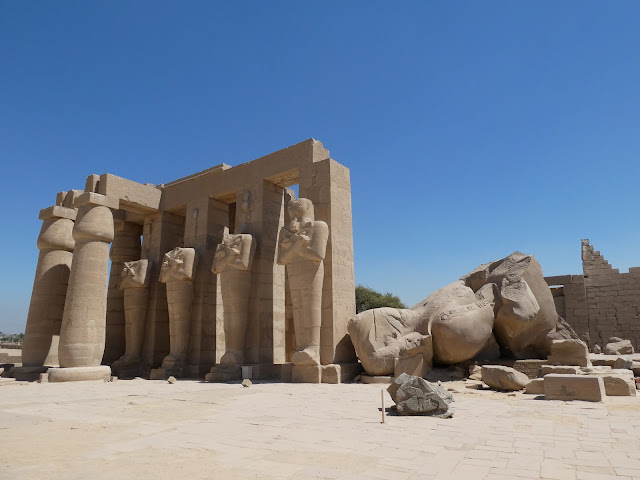









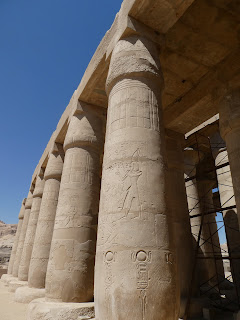








































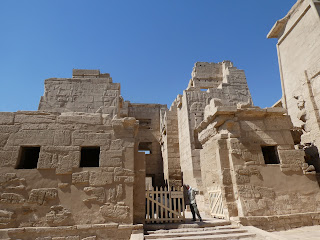





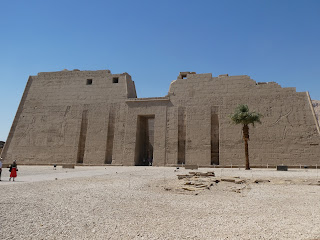


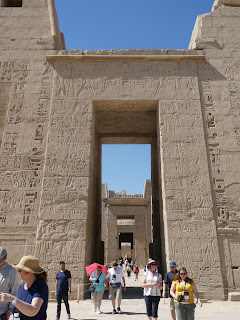


















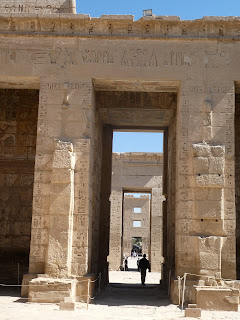

























No comments:
Post a Comment